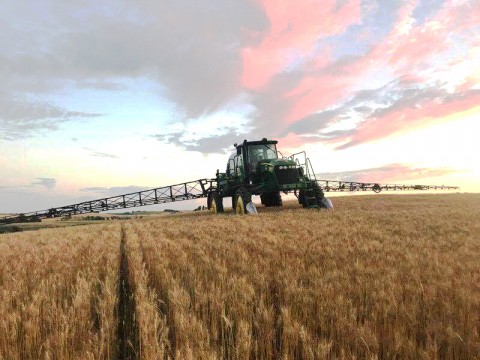The world’s most widely used herbicide — glyphosate — has been a hot topic in North American news recently, after its maker, Monsanto, was found liable for the cancer of groundskeeper Dewayne Johnson.
This is the first lawsuit of its kind to go to trial in the United States, with the company ordered to pay $289 million in damages by a San Francisco jury. This verdict has caused many to second guess the safety of the substance.
Glyphosate is a key ingredient in over 750 herbicides worldwide, including Roundup. Developed by Monsanto in 1974, it is now approved for over 100 different crops and used in 130 countries. It acts on a plant’s EPSPS enzyme, causing a protein shortage in the plant that leads to its death.
Roundup must be diluted with water before it is applied. For each acre sprayed, only 360 grams of glyphosate is actually present — less than one third of a drop of water per square foot.

A crop sprayer drives across a field in Saskatchewan.
Glyphosate is a highly valued tool for farmers as it makes many efficient, sustainable farming practices possible. As a broad-spectrum herbicide, glyphosate works on grasses, broadleaf weeds and woody plants and is used to kill weeds in a field before seeding.
The development of herbicide-tolerant crops, like Roundup Ready canola, allows farmers to spray Roundup onto the actual crop. This treatment will kill any remaining weeds and ensure precious soil resources are used only by the crop.
Farmers’ ability to control weeds with glyphosate has allowed them to abandon destructive farming practices, like tillage, in favour of more environmentally friendly no-till cropping.
By discontinuing these old techniques, farmers are able to contribute to building soil health. Healthy soil reduces topsoil erosion and sequesters carbon from the air into the soil.
Glyphosate has been linked to cancer ever since a 2015 decision by the World Health Organization’s International Agency for Research on Cancer, which classed the substance as “probably carcinogenic” — categorizing it as a Group 2A carcinogen. The report was widely criticized for being incomplete and biased.
It was later contradicted by Health Canada’s Pest Management Regulatory Agency in 2015 and by the Environmental Protection Agency in 2017 — both organizations found glyphosate to be “unlikely to pose a human cancer risk.”
Yet, the IARC’s report was still used in the cornerstone argument posed by Johnson’s legal team, and they won their case. How is this possible?
IARC classifications are assigned by a panel of experts based on the amount of scientific evidence demonstrating a substance’s cancer risk to humans. The Group 2A “probable” classification means there is sufficient evidence in animal tests but limited evidence from actual human trials — this is important because humans and animals can react differently to the same substances. In other words, further research is still required.
Group 1, by contrast, categorizes substances for which there is sufficient evidence of carcinogenicity in humans and includes cigarettes, asbestos and processed meats like bacon and hot dogs.
When the IARC classified processed meats as carcinogenic in 2015, consumers were quick to downplay the results and defend their favourite foods, yet consumers were far less measured in their reaction to the weaker 2A classification of glyphosate that same year.
In health research, no single study can definitively prove that a single factor causes cancer. There are often many variables that coexist, each of which contributes to the risk of disease. The risk-to-disease association increases when there is evidence that can point to a correlation between the two. This has not been the case with glyphosate — many laboratory studies using rodents do not consider it carcinogenic, very few human studies exist, and those that do are not conclusive.
So how was a non-expert jury able to find Monsanto liable for Johnson’s cancer when even scientists cannot conclusively agree? Is it possible that jury members had an emotional reaction against the corporation and allowed that to govern their decision over the actual science?
Monsanto said in a statement that it plans to appeal the decision. However, now that they have been found guilty, the onus is on them to provide compelling evidence that glyphosate is safe. Scientifically speaking, this is next to impossible.
The benefits of glyphosate for farmers are undeniable, but even if further studies do somehow exonerate Monsanto, will consumers be able to get past their feelings and let science be the final judge?
—
Amy Carruthers, Ashly Dyck, Ryne Keller
Photo: Lauren Moses